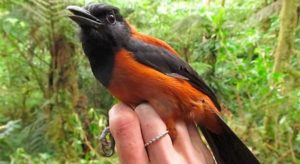The Hooded Pitohui, a vibrant bird native to New Guinea, holds a secret beneath its colourful plumage. While its appearance might entice, this bird is one of the most poisonous in the world. Its skin and feathers are laced with a potent neurotoxin called batrachotoxin, the same poison found in deadly dart frogs.
The presence of batrachotoxin in the Hooded Pitohui is a testament to nature’s incredible adaptations. This potent poison acts as a formidable defense mechanism, deterring predators and ensuring the bird’s survival. When ingested in high enough doses, batrachotoxin can induce paralysis and even death. This makes the Hooded Pitohui a cautionary tale for any creature seeking to make it a meal.
Scientists believe the Pitohui’s toxicity is a result of a symbiotic relationship with a specific species of beetle. The beetle is the actual source of the toxin, and the Pitohui, through its diet, acquires and concentrates it within its own body. This is a prime example of how nature’s intricate web of interactions can result in both beauty and danger.
The story of the Hooded Pitohui serves as a reminder of the hidden power and complexity within the natural world. It challenges our assumptions about appearance and highlights the importance of understanding the intricate balance of life and death in the wild. While this bird’s beauty is undeniable, it also carries a warning, a stark reminder of the potent defenses nature can create to ensure survival.

 Pazionmedia.com Pazion Media l Latest News l Politics l Sports l Entertainment
Pazionmedia.com Pazion Media l Latest News l Politics l Sports l Entertainment



